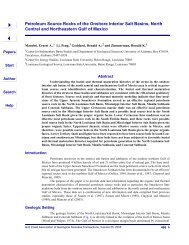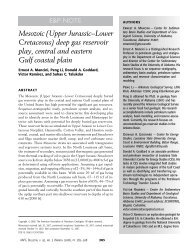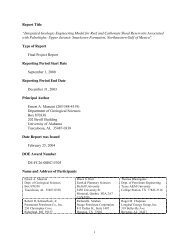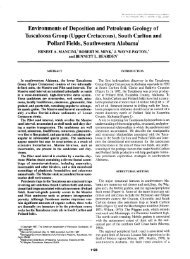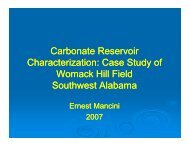Part 4 - Berg - Hughes Center
Part 4 - Berg - Hughes Center
Part 4 - Berg - Hughes Center
Create successful ePaper yourself
Turn your PDF publications into a flip-book with our unique Google optimized e-Paper software.
Reservoir Assessment<br />
Comparison of the geohistory and production history of the North Louisiana Salt<br />
Basin to those of the Mississippi Interior Salt Basin indicates that potential undiscovered<br />
and underdeveloped reservoirs are present in the North Louisiana Salt Basin. From an<br />
assessment of the undiscovered and underdeveloped reservoirs of the Mississippi Interior<br />
Salt Basin by Mancini et al. (2000), the Norphlet, Smackover, Haynesville, Cotton<br />
Valley, Hosston/Sligo, Rodessa/Mooringsport/Paluxy, Dantzler/Andrew/Fredericksburg-<br />
Washita, Tuscaloosa and Eutaw reservoirs were characterized as being productive<br />
throughout most of this basin. Reservoirs with a limited areal extent of production<br />
included the Selma Chalk, Wilcox sandstone, and James Limestone. Potential reservoirs<br />
in this basin were identified as subsalt Triassic Eagle Mills sandstone and Lower<br />
Cretaceous carbonates. Lower Cretaceous Hosston/Sligo, Rodessa/Mooringsport/Paluxy,<br />
and Dantzler/Fredericksburg-Washita sandstone facies and Upper Cretaceous Tuscaloosa<br />
and Eutaw sandstone facies were determined to be underdeveloped reservoirs having<br />
high potential for hydrocarbon productivity.<br />
In the North Louisiana Salt Basin, the subsalt Triassic Eagle Mills sandstone and<br />
deeply buried Upper Jurassic sandstone, shale, and limestone facies of the Smackover,<br />
Haynesville, Bossier, and Cotton Valley are identified as potential undiscovered<br />
reservoirs. Upper Jurassic units account for 20% of the current oil production and 38% of<br />
the current gas production in the Mississippi Interior Salt Basin. The depositional and<br />
diagenetic histories of these strata in the North Louisiana Salt Basin are interpreted to be<br />
similar to those in the Mississippi Interior Salt Basin. These units currently account for<br />
some 10% of the oil production and some 10% of the gas production in the North<br />
442




